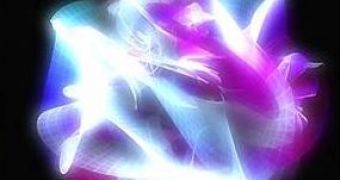We can normally see or experience only four of the dimensions of the universe, three spatial dimensions and a temporal one, but can we be certain that there aren't any others? Ever since it was first constructed, the string theory model of the universe seemed to suggest that the world we live in cannot possibly exist in a four dimensional universe, thus theorists working on it started adding more and more spacial dimensions.
By the time string theory was finally completed, it was already predicting the existence of six or seven spacial dimensions that are so small we cannot possibly perceive them. Nonetheless, physicists all over the world started looking for them by creating models of how one could get evidence of their existence. They predict that signatures left behind by a new class of particles could prove the existence of extra spatial dimensions and could even provide with a rough description of their shape.
String theory proposes that particles, described in the Standard Model as point-like entities, are in fact more like vibrating strings of energy. The different frequencies at which they vibrate through the fabric of space-time gives them their unique physical properties.
Gary Shiu, professor from the University of Wisconsin-Madison, proposes a model in which the shape of the extra spacial dimensions determines the properties of the universe, much in the same way the shape of a musical instrument determines its sound, meaning that string theory predicts that the particle masses and the forces exerted in the universe are in direct relation to the vibrating frequency of the string which, in turn, is given by the shape of the spatial dimensions.
The Large Hadron Collider may be the first one to prove that, indeed, extra spatial dimensions exist, by colliding atomic nuclei with particles traveling at relativistic speeds, interactions which should result in the creation of high energy particles, decaying quickly after. The decay of the high energy particles results in a shower of known particles spreading in different pattern characteristics. Not only does the pattern of decay provide with information regarding the properties of the high energy particle, but it can also reveal the shape of hidden dimensions.
Shiu, with the help of a colleague, Bret Underwood, created a mathematical model in which they studied the decay of the theoretical Kaluza-Klein graviton which could make a clear distinction between a number of extra dimensional geometries proposed by physicists. Shiu says that, according to string theory, graviton particles, especially KK gravitons, are extremely sensitive to the shape of the extra dimensions, which interfere with their behavior and the decay pattern.
At least in principle, physicists should be able to experimentally probe the geometry of the universe, as even the smallest variations in the shape of a spatial dimension would be revealed during the decay of a KK graviton. Last year, the team also suggested that the Cosmic Microwave Background radiation had already provided us with clues that extra spatial dimensions exist.

 14 DAY TRIAL //
14 DAY TRIAL //